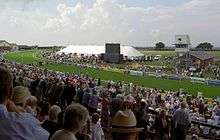Beverley
| Beverley | |
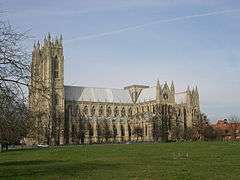 Beverley Minster |
|
 Arms of Beverley Town Council |
|
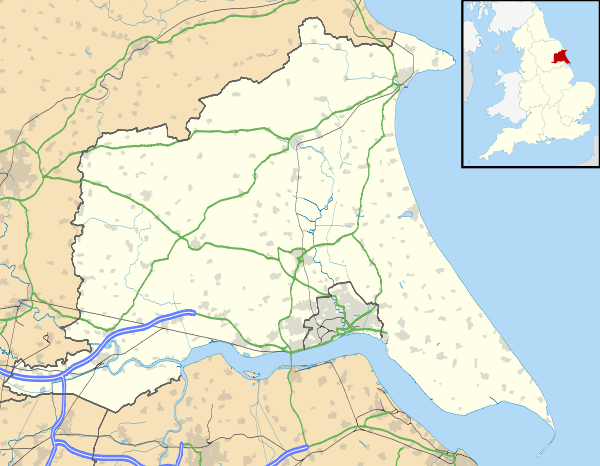 Beverley |
|
| Population | 29,110 (2001 census)[1] |
|---|---|
| OS grid reference | TA035399 |
| Civil parish | Beverley |
| Unitary authority | East Riding of Yorkshire |
| Ceremonial county | East Riding of Yorkshire |
| Region | Yorkshire and the Humber |
| Country | England |
| Sovereign state | United Kingdom |
| Post town | BEVERLEY |
| Postcode district | HU17 |
| Dialling code | 01482 |
| Police | Humberside |
| Fire | Humberside |
| Ambulance | Yorkshire |
| EU Parliament | Yorkshire and the Humber |
| UK Parliament | Beverley and Holderness |
| Website | www.beverley.gov.uk |
Coordinates: 53°50′42″N 0°25′37″W / 53.845°N 0.427°W
Beverley is a market town, civil parish and the county town of the East Riding of Yorkshire, England. The town is noted for Beverley Minster, Beverley Westwood, North Bar (a 15th-century gate) and Beverley Racecourse. Its namesake serves as the origins for the cities of Beverly, Massachusetts,[2][3][4] and, in turn, Beverly Hills in California.[5][6]
The town was originally known as Inderawuda and was founded around 700 AD by Saint John of Beverley during the time of the Anglian kingdom of Northumbria. After a period of Viking control, it passed to the Cerdic dynasty, a period during which it gained prominence in terms of religious importance in Great Britain. It continued to grow especially under the Normans when its trading industry was first established. A place of pilgrimage throughout the Middle Ages due to its founder, it eventually became a notable wool-trading town. Beverley was once the tenth-largest town in England, as well as one of the richest, because of its wool and the pilgrims who came to venerate its founding saint, John of Beverley. After the Reformation, the regional stature of Beverley was much reduced.
In the 20th century, Beverley was the administrative centre of the local government district of the Borough of Beverley (1974–1996). It is now the county town of the East Riding, located 8 miles (13 km) north-west of Hull, 10 miles (16 km) east of Market Weighton and 12 miles (19 km) west of Hornsea. According to the 2001 United Kingdom census the total population of the urban area of Beverley was 29,110 – of whom 17,549 live within the historic parish boundaries.[7] The population of the parish had risen to 18,624 at the time of the 2011 United Kingdom census.[8]
As well as its racecourse and markets, Beverley is known in the modern day for hosting various food and music festivals throughout the year.
History
Northumbrian and Viking period

The origins of Beverley can be traced back to the time of the Anglian kingdom of Northumbria in the 7th century. The first structure built in the area, which at the time was known as Inderawuda (meaning "in the wood of the men of Deira"), was a Christian church dedicated to St. John the Evangelist.[9] This was founded by the Bishop of York who later became known as John of Beverley, who was believed to have performed miracles during his lifetime, and was later venerated as a saint.[9] Around the 850s the now developed monastery was abandoned in a hurry; historians presume this was because of the invasion of the so-called Great Heathen Army of Vikings who had invaded England, and established the Kingdom of Jórvík in the Yorkshire area.[9] However, the population was increased during the 10th century, by people who came to venerate the Saint, John of Beverley.[9]
Before the Battle of Brunanburh, possibly located further north than Beverley, King of England at the time Athelstan visited Inderawuda, he prayed all night and saw a vision saying he would be victorious: in return he helped the town to grow greatly.[9] The name of the town was changed to Bevreli or Beverlac, meaning beaver-lake or beaver-clearing, in the 10th century; a reference to the colonies of beavers in the River Hull at the time.[9] The last three Anglo-Saxon archbishops of York helped Beverley to develop, via the rise in prominence of Beverley Minster and the town in general; along with York itself, Ripon and Southwell, Beverley became one of the most important Christian centres of Northern England. Aldred was declared by king Edward the Confessor as "sole Lord of the Manor of Beverley". Beverley developed as a trade centre, producing textiles, leather and objects made out of antler.[9] Beverley Minster was constructed in 1220 and there were 3 phases to its construction. 1220–1260, 1320–1348 Stopped during the black death and again in 1420–1440 but Beverley Minster is not complete. The Chapterhouse was demolished in 1660 and only the doors remain in the church. the St Martins chapel was also destroyed and was a place of pilgrimage for many, was removed during the dissolution of the monasteries.
Normans and the Middle Ages
After the Norman conquest, many pilgrims flocked to Beverley upon hearing reports of miracles wrought by the town's founder, John. However, much of the North of England rejected Norman rule, and sought to reinstate Viking rule.[9] Towns in Yorkshire were obliterated by the Normans in response, with the Harrying of the North; but Beverley itself was spared, upon the Normans hearing about the town's saintly history.[9] In the 12th century Beverley developed from a settlement of several thousand, to an extensive town, stretching from around the North Bar area to the Beck in an elongated pattern, it was granted borough status in 1122 by Thurstan. Industry grew further, Beverley especially traded wool with the cloth making towns of the Low Countries.[9]

The town suffered a large fire in 1188 which destroyed numerous houses, and damaged Beverley Minster. Lady Sybil de Valines gave the Manor of the Holy Trinity on the east side of Beverley to the Knights Hospitallers in 1201, where they established a preceptory;[10] also to be found in Beverley during the 13th century were Dominican friars who were given some land by Henry III upon which they erected buildings. Franciscans were present.[9] A dispute arose between local farmers and the archbishop during the 13th century, about land rights; after the locals demanded a royal inquiry, the archbishop granted the townspeople pasture and pannage in the Westwood and other places.
During the 14th century, England experienced periods of famine caused by poor weather conditions which destroyed crops. There were other nationwide issues to contend with at the time, such as the Black Death, the Hundred Years' War and the Great Rising. However, Beverley continued to grow: and by 1377, had become the 10th largest town in England.[9]
The earliest surviving secular drama in English, The Interlude of the Student and the Girl (c. 1300), may have originated from Beverley.
Reformation decline in Tudor times
.jpg)
Beverley was reliant on pilgrimage, but changes brought about by the Reformation impacted upon this tradition, and so Beverley declined in status.[9] Local Beverley man, Cardinal John Fisher was martyred along with Thomas More for refusing to accept the Tudor King Henry VIII as Head of the Church of England.[11] In October 1536 there was a popular rising in Beverley where 500 men in the town gathered at the Westwood under the leadership of a local lawyer named William Stapleton, later becoming part of the larger Pilgrimage of Grace in York as part of the 30,000 rebels opposing Henry's new religious laws.[9] Henry followed through with the break from Rome and the Dissolution of the Monasteries, dissolving the Dominican Friary in Beverley and taking their land for himself, the Knights Templars in Beverley suffered the same fate in 1540.[9]
As a result of the tensions across the North of England, governance duties were handed over to the Council of the North so the Tudors could control the area at arm's length.[12] Beverley was visited by John Leland, the man known as the "father of English local history", he wrote of the town in some detail, estimating the population of the time at around 5,000.[9] Beverley Minster was almost demolished by its new owners who wanted to profit from selling its stone and lead, however the local people led by wealthy merchant Richard Gray saved it from this fate.[9] During the time of Elizabeth I, Beverley was endowed with its own mayor; Edward Ellerker was the first to take this position.[13] The gap between Beverley's rich and poor became more pronounced during the Tudor era, due to large unemployment. The substantial drop in pilgrimage to Beverley in honour of its founder John of Beverley, affected the jobs of the working class as that was Beverley's main industry.[9]
Civil war and Restoration recovery
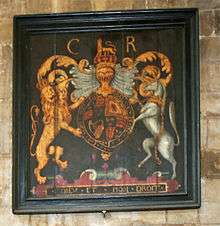
The 17th century began badly for Beverley as many people died of the plague. Due to the close geographical proximity to Hull, focus on the area became magnified when the people of Hull refused to open the gates to Charles I a couple of months before the fighting began in the English Civil War.[14] After being turned away from Hull, the king spent three weeks as a guest in a house at North Bar in Beverley, where he was openly greeted with the ringing of St Mary's Church bells.[9] Beverley was initially royalist: however it was taken by the parliamentarians of Hull, forcing the king to flee. A royalist army led by William Cavendish defeated Thomas Fairfax to reclaim the town for the royalists; from here they launched another Siege of Hull.[15] Eventually the parliamentarians won the civil war and established the Commonwealth of England, in which alehouses were shut on Sundays and theatres and race meetings abandoned: the Puritans visited the then Church of England houses of worship and destroyed anything they thought to be idolatrous.[9]
Beverley Minster managed to escape this fate, in part due to the prominence of the Percy family and the fact that the church housed memorials to their ancestors. Beverley's Quakers were not so fortunate, and were strongly repressed by the Puritans.[9] The English Restoration with Charles II coming to power was generally well received in Beverley, and his royal coat of arms was hung in the Minster and remains there.[9] In terms of trade Beverley was not rich in the 17th century but had improved slightly, the majority were based in agriculture.[9] During the Georgian era, Beverley was the county town of the East Riding of Yorkshire and became the prime market town in the area during the 18th century, beating out competition from Pocklington, Howden and Market Weighton.[9] The replacing of old timber buildings with new ones in the Georgian style helped the town recover in prestige, with the religious structures also undergoing restorations.[9]
Modern Beverley
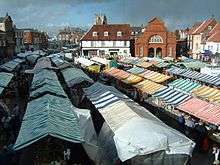
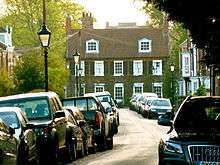

Due to an increase in population, some of the entrances into the town (such as the brick-built Bars) were taken down to accommodate traffic. Although population figures rose steeply, the increase was not as much as in nearby Hull, or most of the rest of England.[9] Beverley's association with religion remained during the 19th century: as well as the majority Anglican faith, there were several non-conformist religions practised such as Methodism with John Wesley previously having preached there; with the completion of the Catholic Emancipation and the refoundation of the Catholic hierarchy, the Diocese of Beverley in 1850 was chosen to cover Yorkshire, before being divided into two dioceses.[9]
Communications were improved with the opening of the Beverley railway station during October 1846.[9] During the Industrial Revolution Beverley's people retained most agricultural jobs, though there was a presence of iron workers within the town.[9] In 1884 Andrew Cochrane founded a shipyard at Grovehill on the River Hull. It was purchased by Cook, Welton & Gemmell in 1901.[16] The yard was a leading builder of trawlers for the Hull deep-sea fishing fleet. In both world wars the yard built minesweepers for the Royal Navy. The deep-sea trawler Arctic Corsair now preserved in Hull was built there in 1960. The yard closed for ship construction in 1977 and the site is now used for boat repairs.
A permanent military presence was established in the town with the completion of Victoria Barracks in 1878.[17] The barracks closed in 1977, and the only army presence in the area is now the Defence School of Transport at Normandy Barracks Leconfield, two miles to the north.
In the First World War the Royal Flying Corps had an airfield on the Westwood.[18] The site is now Beverley Racecourse
The Second World War saw the nearby city of Hull suffer significantly from aerial bombardment: however, Beverley was more fortunate and did not endure such heavy attacks.[9] Since the war, Beverley has gone through some remodelling, and has grown in size. It attracts thousands of tourists each year who come to view the religious buildings and visit Beverley Racecourse.[9] In 2007 Beverley was named as the best place to live in the United Kingdom in an "Affordable Affluence" study by the Royal Bank of Scotland.[19]
Noteworthy landmarks
- Newbegin House
- Beverley Minster
- St Mary's Church
- North Bar
- Beverley Racecourse
Governance
During the Middle Ages, Beverley was governed by aldermen known as the twelve keepers, they oversaw the general running of the town and the maintaining of law and order.[20] The borough corporation was reformed by the Municipal Corporations Act 1835 and formed the local government of the town until 1974.[21] In 1974, following the Local Government Act 1972, the former area of Beverley borough was merged with Beverley Rural District and Haltemprice Urban District to form an enlarged Beverley borough in the county of Humberside.[22] Since 1996 it has formed part of the East Riding of Yorkshire district and is the county town, as it was before 1974.[22]
Beverley was represented in the Houses of Parliament by the Member of Parliament of Yorkshire until Beverley was given parliamentary borough status from 1563.[22] Beverley was able to elect two MPs for its entire time as a parliamentary borough; the right of election was vested not in the population as a whole, but in the freemen. Elections became notorious for their corruption, to the extent that the constituency was abolished in 1870 and incorporated into the East Riding constituency.[22] During the 1950 general election a Beverley county constituency was created, covering half of the East Riding, with Bridlington covering the other half.[22] It became part of the Haltemprice constituency in 1955, until it reverted to the Beverley constituency in 1983.[22] Since 1997 Beverley has been part of the Beverley and Holderness constituency, a Conservative Party stronghold.[22]
| Position | Current representatives |
|---|---|
| Member of Parliament | |
| Beverley Town Council |
Elaine Aird – Conservative, |
Planned expansion
Local authorities plan to build 3,300 new Beverley houses,[23] which will increase the size of the town by 20%. East Riding of Yorkshire Council said: "The evidence recognises that the East Riding is generally a high demand area with strong levels of in-migration"[24][25] Resident David Tucker, of the North Beverley Action Group, said: "Beverley is under attack in every direction. Why on earth is East Riding Council volunteering this town to be sacrificed by allowing ridiculously large numbers of houses to be built under its Local Plan? Beverley has taken a far greater percentage of housing development than any other town in the East Riding. Enough is enough, the future of this market town is under threat. It is very difficult for the average person in Beverley to deal with this huge number of attacks we are facing, it's coming from every direction." He added, "You feel you are being steamrollered... We are giving away our heritage."[26]
Education

Beverley is home to the oldest state school in England, in the form of Beverley Grammar School. The school was founded in 700 AD by Saint John of Beverley.[27] Several notable alumni have attended the school, including chemist Smithson Tennant, who discovered iridium and osmium, Thomas Percy, who was involved in the Gunpowder Plot and Paul Robinson, a football goalkeeper who has represented England national football team (2003–2009).[27] In the modern day the school hosts around 800 pupils and has received favourable reports from Ofsted, however, in 2013 it was determined as requiring improvement.[27]
There are other schools in Beverley, such as Beverley High School, which is a comprehensive school for girls: it has around 850 pupils, and is well above the national average based on the results of GCSE test performances.[28] Beverley Grammar School and Beverley High School share a common sixth form, called the Beverley Joint Sixth.

Longcroft School is a co-educational school, with around 1,500 pupils consisting of both boys and girls. Longcroft School was founded in 1949 and officially opened in 1951, and is home to the Longcroft Gospel Choir, founded by Jonathan Chapman. The choir is well known in the local area, and regularly performs at parties, ceremonies, weddings and music concerts. The choir comprises pupils from Year 9 and above and several members of Longcroft School staff, and has a large repertoire of music. Over the choir's period of existence, the choir has performed at venues such as Disneyland Paris and the Apple Store on Oxford Street, London, have released two of their own albums and have featured on a track by singer songwriter Henry Priestman. But more recently in May 2015, it was announced that the Longcroft Gospel Choir will be one of twenty choirs in the UK to perform at and open the 2015 Rugby World Cup in London performing for the home team (England), a brilliant achievement for the school and the young people in the choir.
East Riding College has a campus in Beverley. The college offers various further education courses for school leavers and adults from the town. For higher education students from Beverley either attend nearby institutions such as the University of Hull, or ones further afield depending on test results.
Media
Beverley and the East Riding of Yorkshire region is served by the East Riding Mail, which is similar to the Hull Daily Mail.
Radio stations BBC Radio Humberside, Viking FM and KCFM serve the town and the whole of the East Riding of Yorkshire but, are based in the nearby city of Hull.
Kingstown Hospital Radio serves the East Riding Community Hospital, in addition to the Hull Royal Infirmary and Castle Hill Hospital in nearby Cottingham.
Beverley has its own radio station 107.8 Beverley FM, which broadcasts to Beverley and its surrounding area from the studio based in the town.
Religion

Beverley's largest religious denomination is Christianity; 79.9% of the people in the area polled as part of the United Kingdom Census 2001 professed the Christian faith, 8% above the national average.[29] Beverley Minster contains a tomb said to contain the bones of Saint John of Beverley who founded a monastery here and with it the town; another notable saint from Beverley is Saint John Fisher. The minster was designated a Grade I listed building in 1950 and is now recorded in the National Heritage List for England, maintained by Historic England.[30]
The Church of England are in the majority with three parishes; the ancient Beverley Minster, St. Mary's Church (designated a Grade I listed building in 1950 and is now recorded in the National Heritage List for England, maintained by Historic England[31]) and St. Nicholas Church.[32] Beverley is a suffragan bishopric of the Diocese of York represented by the Bishop of Beverley, created in 1994 to provide a provincial episcopal visitor for the Province of York. The form of Anglicanism in Beverley is more on the Anglo-Catholic side of the scale, represented with the bishop being a member of the Society of the Holy Cross. There is one Roman Catholic church in Beverley called St. John's, it is covered by the Diocese of Middlesbrough; when the Catholic Emancipation was complete in 1850 the Diocese of Beverley was inserted to cover all of Yorkshire, but it was later broken up into smaller dioceses.[9] Methodism is also represented in Beverley with around three places of worship.
Since their suppression in the 17th century, Quakers established a meeting house and have worshipped in Beverley ever since. Their present meeting house – the third – in Quaker Lane – was built in 1961.
Missionaries of the Church of Jesus Christ of Latter-day Saints from the United States first arrived in Beverley in 1850 and quickly established a local congregation. In 1963 a large new chapel on Manor Road was built by local church members. Due to the continued growth of the Beverley congregation both the building and car parks were enlarged in the late 1990s.
Culture
As a market town, the market day is central to culture in Beverley; a smaller market day is held on Wednesday: however the main event is on Saturday, with all of the stalls.[33][34] Throughout each year there are various annual music festivals in the town, catering for different kinds of music. These include the Early Music Festival in May; the Beverley Folk Festival in June, which features three days of folk music, comedy and workshops; the Jazz Festival in August, followed by the Chamber Music Festival in September.[9] Held monthly at the Beverley Memorial Hall is a local music event Sunday Live. It is also home to the popular Beverley Male Voice Choir.
Beverley hosts an annual literature festival, kite festival, a biannual puppet festival and Beverley town fair.
In terms of sport, the most noted field of participation is horse racing with Beverley Racecourse. The sport has a long history in Beverley, with evidence of a permanent race track reaching back as far as 1690, while its first grandstand was built in 1767.[35] The town is represented in football by Beverley Town, who currently play in the Humber Premier League. Beverley was the host for the 2006 British National Cycling Championships. Beverley Westwood is home to the oldest golf club in Yorkshire the Beverley and East Riding Golf Club founded in October 1889.
Beverley town has a variety of public houses, some of which have become tourist attractions.[36] Examples include the Sun Inn, the town's oldest public house dating back to around 1530.[37] There are over 40 public houses in Beverley – the vast majority have been there for over a century.[36] Beverley is home to one of the last pubs in the world to still use authentic gas lighting; The White Horse Inn (or "Nellie's" to the local population) is owned by the Samuel Smith Brewery company.[38]
Since 2006, Beverley Town Council has run an annual food festival in October. Including 70 stalls selling food produced in Beverley and the East Riding of Yorkshire, a 200-seat food theatre marquee, cookery demonstrations from top local chefs, street entertainment and more, the day-long event is enjoyed by upwards of 10,000 residents and visitors.
In 2012 St Mary's Church in Beverley hosted the first real ale and cider festival. Over 2,000 people attended the event. The festival has now moved to the Beverley Memorial Hall and still attracts over 2,500 people.[39]
Transport
The town is served by Beverley railway station on the Hull to Scarborough Line with services currently run by Northern and a limited service between Beverley and London King's Cross provided by Hull Trains. Before the mid 1960s there was a direct York to Beverley Line via Market Weighton; the Minsters Rail Campaign is seeking to re open the closed line.[40]
Beverley railway station was opened in October 1846 by the York and North Midland Railway and gained junction status nineteen years later when the North Eastern Railway opened its line to Market Weighton and York.[9] The railway station, designed by George Townsend Andrews is now a Grade II listed building and has an elegant overall roof.[9]
The five-mile (8 km) £13 million A1079 Beverley Bypass opened in May 1980; the road links York and Hull.[41] East Yorkshire Motor Services provide good, regular bus links with Hull city centre as well as links to local surrounding villages and places such as Hessle, Pocklington, Driffield, Market Weighton, Bridlington, York and Scarborough.[42] Beverley Beck is a canal which gives boats access to the town from the River Hull. The beck is used by fishermen for catching a large variety of fish such as pike, bream and carp.[9] Previously the Beverley Beck used to form a more significant role in transport as part of the trade industry, where Beverley was a trading post of the Hanseatic League.[9] It remains as home to the Beverley Barge Preservation Society in the modern day.[43]
Literature
Beverley is the main setting for Domini Highsmith's "Father Simeon" trilogy: "Keeper at the Shrine" 1994, "Guardian at the Gate" 1995 and "Master of the Keys" 1996.
Notable people
- William Binnington Boyce (1804–1889) philologist, clergyman
- Lindsey Chapman (born 1984), actress and TV and radio presenter
- George Collison (1772–1847), academic, theologian
- William Dixon, politician
- John Fisher (1469–1535), bishop, cardinal, saint, martyr[44]
- Peter Goy (born 1938), footballer
- Alfred Hutton (1839–1910), Victorian officer, antiquarian and swordsman
- Gerry Ingram (born 1947), footballer
- Andrea Jenkyns (born 1974), Member of Parliament Morley and Outwood
- Jemma McKenzie-Brown (born 1994), Tiara Gold High School Musical 3: Senior Year
- Anna Maxwell Martin (born 1978), actress
- John Merbecke (1510–1585), theologian, musician
- Katie O'Brien (born 1986), tennis player[45]
- Julia Pardoe (1806–1862), poet, novelist, historian
- Thomas Percy (1560–1605), Gunpowder plotter[46]
- Dave Phillips (born 1987), Great Britain men's national ice hockey team, Lake Erie Monsters (AHL)
- Paul Robinson (born 1979), footballer
- Suhayl Saadi (born 1961), writer
- Mike Score (born 1957), keyboardist, singer
- Guy Smith (born 1974), 2003 24 Hours of Le Mans winner
- Neil Thompson (born 1963), footballer
- Eleanor Tomlinson (born 1992), actress
- Danny Worsnop (born 1990), vocalist of We Are Harlot (Former vocalist of Asking Alexandria) [47]
Twin towns
 Nogent-sur-Oise in France
Nogent-sur-Oise in France Lemgo in Germany
Lemgo in Germany Beverly, Massachusetts – named after Beverley in 1688
Beverly, Massachusetts – named after Beverley in 1688
See also
Notes
- ↑ "KS01 Usual resident population: Census 2001, Key Statistics for urban areas" (Excel). National Statistics. Retrieved 3 February 2013.
- ↑ Rev. E. M. Stone History of Beverley (Mass.), from its settlement in 1630 to 1842. 12mo. Boston, 1843
- ↑ Genealogical and Personal Memoirs – Page 1460 William Richard Cutter "Mr. Balch was born in Beverley, Massachusetts, September 30, 1704, and died in Bradford (Grove- land) January 12, 1791–2."
- ↑ Los Angeles Magazine – December 1996 – Page 99 Vol. 41, No. 12 "Beverly Farms appears to have been named for the nearby town of Beverly, which was in turn named for Beverley, England. That Yorkshire cathedral town was named in the 8th century or so for an earlier settlement called Beverlac – a ...
- ↑ Alexander Garvin (19 June 2002). The American City. McGraw-Hill Professional. p. 383. ISBN 978-0-07-137367-8. Retrieved 18 August 2012.
- ↑ Marc Wanamaker, Early Beverly Hills, Mount Pleasant, South Carolina: Arcadia Publishing, 2005, pp. 17–18
- ↑ "2001 Census: Key Statistics: Parish Headcounts: Area: Beverley CP (Parish)". Neighbourhood Statistics. Office for National Statistics. Retrieved 14 May 2008.
- ↑ "Key Figures for 2011 Census: Key Statistics: Area: Beverley CP (Parish)". Neighbourhood Statistics. Office for National Statistics. Retrieved 3 February 2013.
- 1 2 3 4 5 6 7 8 9 10 11 12 13 14 15 16 17 18 19 20 21 22 23 24 25 26 27 28 29 30 31 32 33 34 35 36 37 Hopkins, Pamela. The History of Beverley, East Yorkshire. Blackthorn Press. ISBN 0-9540535-9-1.
- ↑ "Houses of Knights Hospitaller". British-History.ac.uk. Retrieved 4 March 2008.
- ↑ "Saint John Fisher, Bishop & Martyr". wf-f.org. 24 October 2007.
- ↑ "Pilgrimage of Grace". Spartacus.schoolnet.co.uk. 24 October 2007. Archived from the original on 24 April 2008.
- ↑ "The Mayor of Beverley". Beverley Town Council. 24 October 2007.
- ↑ "Seeds of the English Civil War". BBC. 25 November 2007.
- ↑ "The Sieges of Hull during the Great Civil War". 20. 24 October 2007: 457–473. JSTOR 548730.
- ↑ http://www.gracesguide.co.uk/Cook,_Welton_and_Gemmell
- ↑ "Public Institutions, A History of the County of York East Riding: Volume 6: The borough and liberties of Beverley". 1989. pp. 190–195. Retrieved 11 November 2014.
- ↑ http://www.hullandeastridingatwar.co.uk/index.php/erairfieldss/rfcbev
- ↑ "Beverley 'is the top place to live in Britain'". Yorkshire Forward. 3 September 2007. Retrieved 3 August 2009.
- ↑ Kermode, Jennifer. Medieval Merchants: York, Beverley, and Hull in the Later Middle Ages. Cambridge University Press. ISBN 0-521-52274-9.
- ↑ Great Britain Historical GIS / University of Portsmouth, Beverley (historic map). Retrieved on 15 July 2008.
- 1 2 3 4 5 6 7 "Modern Beverley – Political and Social History". British-History.ac.uk. 3 September 2007. Retrieved 24 October 2007.
- ↑ "Developers 'champing at the bit' with 3,300 homes to be built in Beverley". Hull Daily Mail. 8 November 2014. Retrieved 30 August 2016.
- ↑ "Policy S5: Delivering housing development". East Riding of Yorkshire Council. Retrieved 30 August 2016.
- ↑ "Land to the South West of Beverley Draft Masterplan (compressed).pdf". Retrieved 30 August 2016.
- ↑ "Beverley residents: 'We're under attack from house builders'". Hull Daily Mail. 20 January 2014. Retrieved 30 August 2016.
- 1 2 3 "School History". Beverley Grammar School. 3 September 2007. Archived from the original on 27 July 2010. Retrieved 24 October 2007.
- ↑ "Beverley High School". BBC News. 3 September 2007. Retrieved 24 October 2007.
- ↑ "Beverley and Holderness". UKPolingReport.co.uk. 3 September 2007. Retrieved 24 October 2007.
- ↑ Historic England. "The Minster Church of St John (1084028)". National Heritage List for England. Retrieved 13 August 2013.
- ↑ Historic England. "The Parish Church of St Mary (1162693)". National Heritage List for England. Retrieved 13 August 2013.
- ↑ "Churches". BeverleyInPictures.co.uk. 3 September 2007. Archived from the original on 13 October 2007. Retrieved 24 October 2007.
- ↑ "Market Days" (PDF). DiscoverYorkshireCoast.com. November 2007. Retrieved 24 April 2010.
- ↑ "Council Markets". East Riding of Yorkshire Council. Retrieved 24 April 2010.
- ↑ "Beverley Racecourse". GreyhoundDerby.com. 24 October 2007.
- 1 2 "About". BevPub.co.uk. 3 September 2007. Retrieved 24 October 2007.
- ↑ "The Sun Inn". BevPub.co.uk. 3 September 2007. Archived from the original on 22 April 2008. Retrieved 24 October 2007.
- ↑ "The White Horse (Nellies)". BevPub.co.uk. 3 September 2007. Retrieved 24 October 2007.
- ↑ "Beverley Real Ale Festival". Retrieved 25 March 2013.
- ↑ "Minsters Rail Campaign". www.minstersrail.net. Retrieved 31 August 2014.
- ↑ "Graham Stuart MP – working hard for Beverley and Holderness". GrahamStuart.org.uk. 3 September 2007. Retrieved 24 October 2007.
- ↑ "Beverley". CarlBerry.co.uk. 3 September 2007. Retrieved 24 October 2007.
- ↑ "Six of the Best – Beverley's Best Bits!". Beverley Town Council. 3 September 2007. Archived from the original on 18 February 2012. Retrieved 12 November 2014.
- ↑ Huddleston, Gilbert (1910). "St. John Fisher". The Catholic Encyclopedia. Vol. 8. New York: Robert Appleton Company. Retrieved 23 June 2015.
- ↑ "WTA Profile – Katie O'Brien". Women's Tennis Association. Retrieved 23 June 2015.
- ↑ De Fonblanque, Edward Barrington (1887). Annals of the house of Percy, from the conquest to the opening of the nineteenth century. Vol. 2. London: R Clay and Sons. p. 252.
- ↑ "Asking Alexandria – Sumerian Records". Retrieved 28 January 2015.
Bibliography
- Taylor, Isaac (1898). Names and Their Histories. London: Rivington's. p. 68.
- Gazetteer – A–Z of Towns Villages and Hamlets. East Riding of Yorkshire Council. 2006. p. 3.
- Historic Beverley. William Sessions Ltd. 1973. p. 108. ISBN 0900657154.
 Chisholm, Hugh, ed. (1911). "Beverley". Encyclopædia Britannica. 3 (11th ed.). Cambridge University Press.
Chisholm, Hugh, ed. (1911). "Beverley". Encyclopædia Britannica. 3 (11th ed.). Cambridge University Press.
External links
| Wikimedia Commons has media related to Beverley. |
| Wikivoyage has a travel guide for Beverley. |
